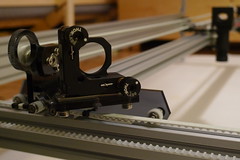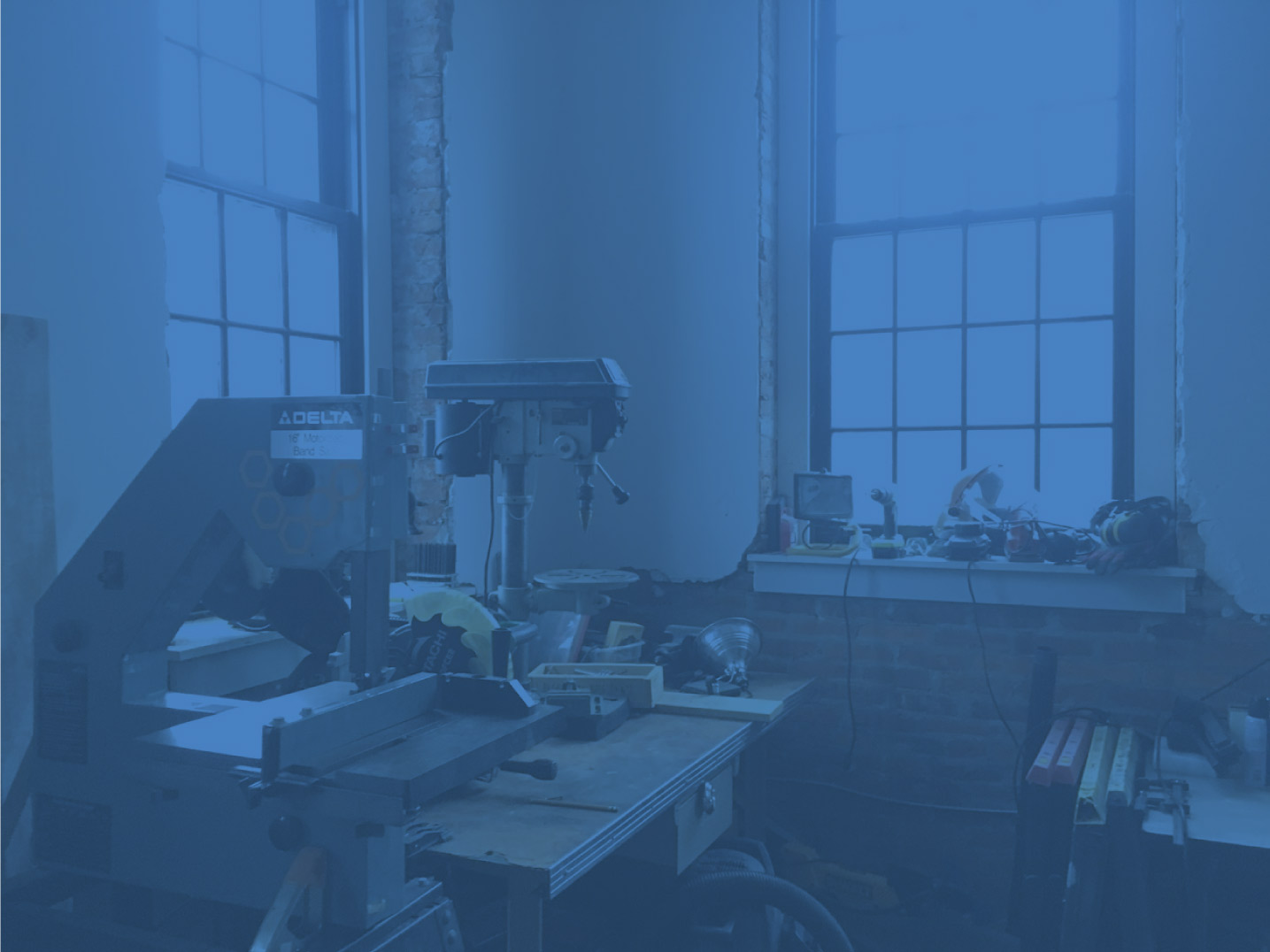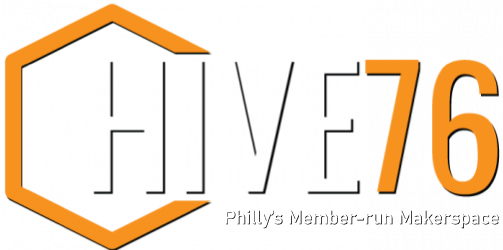Two days to go until Christmas, and after a full day of last minute shopping, I still hadn’t found a decent gift for my mom. Around 9:00, the bookstore closed up, and I was still S.O.L. Then, inspiration struck, and I raced over to Hive76, where I worked into the early morning handcrafting the perfect D.I.Y. present for my artist mom: a wooden paintbrush organizer! Luckily, there were some choice pieces of birch plywood at the space, and a really nice scrollsaw (which was actually a gift from my mom last Christmas, so I was putting it to good use). Amazingly, all the pieces fit together beautifully, and my mom was thrilled with her gift. Hive76 saved Christmas!
Laser Pledgie update
We still want a laser, but now we have a bit more of a focus. Much like the open source hardware Makerbot is for printing, Lasersaur will be an open source laser cutter. 
Hive76 really wants to make one! So we have adjusted the pledgie where we are collecting donations to match the new goal: $2000. Here’s the cost breakdown:
- $570 Lasersaur Alpha kit: optics, electronics, belts, fasteners
- $500 Extruded aluminum rails
- $700 Fume extractor for exhaust
- Remaining funds for unseen costs
- Free: Laser tube from Meatcards, Stepper motors from Meatcards or elsewhere, Paneling is nominal.
As before, your pledge will be rewarded with laser time at a dollar per minute. Also, any $10 pledge gets some not-yet-designed lasercut trinket!
Let’s make it happen!

We Won the Open Science Design Contest

Great news, The Citizen Science Quartely just picked the winner for the Open Science Design Contest, and:
WE WON!!!!!!!!1111!!111one
You can read more about the original entry HERE.
We’ll be using the Ponoko gift certificate to design a housing for the electronics and make it more kit-able. Bench Science FTW!
And definitely check out the Kickstarter for The Citizen Science Quarterly. It’s shaping up to be a really interesting mix of Bench Science in the DIY spirit. From the Kickstarter page:
“We’d like to create a magazine for the scientist in all of us.
It will have simple How-To’s, like extracting the DNA of a strawberry using kitchen materials. But on the next page could have a paper on the validity of using Bacillus Subtillus as a model organism. We’d feature extraordinary citizen scientists who are doing extraordinary things in abnormal labs (aka garages, closets, etc). We’d also give legal and safety tips to inform and protect citizen scientists from some of the dangers they could run into.”
Making things Blink and Buzz!
 Ever wanted to learn more about electronics but weren’t interested in taking a long, drawn out class on theory? Are you looking for a class that will pique your interest and spark your creative flow?
Ever wanted to learn more about electronics but weren’t interested in taking a long, drawn out class on theory? Are you looking for a class that will pique your interest and spark your creative flow?
Then join us at Hive76 for “Making things Blink and Buzz” on January 29th. Join us for a day filled with blinking, buzzing and all out DIY geektopia. The class is open to anyone who is curious about electronics of all skill levels. The only requirement is a willingness to learn and a desire to have a lot of fun while doing it. Example projects will include a 555 timer and an Atari Punk Console (if you don’t know what these are then you definitely should come and find out). These projects are hands on, beginner friendly, and cool kit to take home and keep playing with, so grab a seat in the class before it sells out.
If you’re still unsure, Hive76 will be offering a free preview of this class during one of the weekly open houses in January. Far will be demonstrating how to build a “blinky bug.” Come meet the Hive76 crew, and find out how much fun DIY electronics can be!
Class: Making Things Blink and Buzz
Date: Saturday, January 29, 2010 from 10AM – 4PM (with an hour break for snacks)
Cost: $40 (Includes 4+ hours of class, as well as parts and materials).
We have only 15 seats, so get your Tickets soon.
Open House and Studios recap
The building we rent space from, 915 Studios, hosted Open Studios this past weekend. While most of us don’t make art, we did want to show off our cool projects to any visitors. I set up my DIY time lapse intervalometer and took pictures every 9 seconds all Saturday. Here is the completed video.
Hive76 Open House from Chris Thompson on Vimeo. Also, buy that music. It’s amazing.
We also installed a new extruder in 3DPO, the Plastruder MK5. A lot of cool stuff was printed. Here’s a video of some successful printing:
Fynflood also got his Mendel up and running again. And printed a Hackaday skull:

How I Became a Maker
 Probably the single most important decision about me that my parents made was to remove me from the institutional education systems and home school me. There was talk from my teachers of getting me diagnosed with Attention Deficit Disorder, but really I was just bored with my classes and had no socially acceptable concept of how to deal with that boredom (incidentally, I still don’t, but that’s a story for another day). Unfortunately for Mom and Dad, they quickly learned that my disruptive, destructive tendencies would be visited upon them if they did not find ways to entertain me.
Probably the single most important decision about me that my parents made was to remove me from the institutional education systems and home school me. There was talk from my teachers of getting me diagnosed with Attention Deficit Disorder, but really I was just bored with my classes and had no socially acceptable concept of how to deal with that boredom (incidentally, I still don’t, but that’s a story for another day). Unfortunately for Mom and Dad, they quickly learned that my disruptive, destructive tendencies would be visited upon them if they did not find ways to entertain me.
Enter: TOPS Science.
TOPS is brilliant. It’s a combination of comic book and pragmatic science lab. Everything in a TOPS science workbook can be done with house hold items. The topics cover a wide range: electricity, chemistry, biology, geology, meteorology–I wouldn’t be surprised if they eventually came out with a nuclear physics issue. I couldn’t get enough of them.
The materials were always simple, and something you probably had lying around anyway. For example, the electric circuits module used aluminum foil backed with scotch tape for wires, paper clips to connect them, and clothesline clips and rubber bands to make a flashlight bulb holder. There were never any exotic parts or chemicals in a TOPS module, and if something was slightly out of the ordinary, it would show you a convenient source for scavenging it from some thing else.
Even after all of the worksheets were done, I would still continue to play with the left over pieces, hooking up DC motors vultured from broken toys, making LEGO gears, testing out rubber-band belt drives, building switches made from bent-up paper clips and aluminum foil, and winding solenoids from ballpoint pens and wire from who-knows-where.
Some things that resulted from a combination of my boredom, ingenuity, and youthful ignorance:
- A small catapult with a surprisingly long range and a poorly thought-out target area (i.e., a plate glass window).
- A coil gun that scared the family dog into knocking over a ceramic vase.
- Experiments in electrolyzing water for basic hydrogen and oxygen that resulted in several toxic chemicals as well as one small explosion.
- Experiments in electroplating objects with metal from nails and paper clips that looked suspiciously a lot like the previous entry with largely the same results.
It was that second, small explosion that prompted my parents to buy me a computer as a compromise to prevent me from continuing with my increasingly dangerous pursuits in the physical sciences. But, I still carry the basic principles of analog circuits because of these awesome, little books. I don’t know what I ever did to deserve them because it would often lead to new ways for me to endanger my life/the carpet, but they are perhaps the most significant part of how I came to be a builder and maker of things.
Open Source Orbital Shaker

Here is my entry for the Open Call for Open Science Equipment Contest.
I did this with help from Mike, Jack, Rob, Adam and others right here at Hive76. Thanks everyone!
Details and all source files for this project are available on Thingiverse.
The deadline for submission is December 15th, so if you have an idea for open source equipment you still have some time to submit your entry to the contest!
Open Source Orbital Shaker from jmil on Vimeo.
Join us for Open Art Studio this Weekend!

Our entire building at 915 Spring Garden is taking part in Open Art Studios this weekend, and we’ll be there too!
Almost 30 studios will be open to the public, including Hive76! There’s a ton of different medias people use, everything from textiles to clays to electronics.
Come join us on Saturday and Sunday, December 4th and 5th, from noon – 5 pm at Hive76. We’ll also be upgrading our MakerBot with a new MK5 Extruder so we’ll be printing in tip-top shape again soon!
Open House, December 1st, 2010

We enter the cold, dark days of December with a super Open House meeting. As always, the night starts off with our 7pm Scrum stand-up meeting for members to update everyone on the progress of their projects. 8pm starts the official Open House, with pizza, soda, and snacks.
Keeping in our new tradition of “mini projects for open houses”, Adam and Jack will be showing everyone the basics of building electric motors. Previous open houses covered Glowsticks and Bristle Bots. Building simple motors is really a lot easier than you might initially think. Hand-made electric motors are a fun way to learn basic principles of circuits as well as a handy skill for any project that needs a little movement. Come on down and play with electromagnetic fields with us!
Coding and gender: linkspam
A coder for the Diaspora project changed a dropdown to indicate gender into a text field. In the author’s words, “I’ve gotten comfortable with the idea of gender as an n-dimensional space, with two big clusters and a hell of a lot of outliers.” Interesting stuff, with points of discussion about both identity and data mining.


